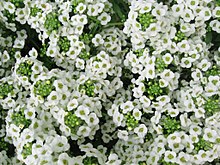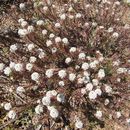Distribution in Egypt
provided by Bibliotheca Alexandrina LifeDesk
Nile and Mediterranean regions, Sinai.
- author
- BA Cultnat
- provider
- Bibliotheca Alexandrina
Global Distribution
provided by Bibliotheca Alexandrina LifeDesk
Macaronesia, Mediterranean region.
- author
- BA Cultnat
- provider
- Bibliotheca Alexandrina
Associations
provided by BioImages, the virtual fieldguide, UK
Foodplant / internal feeder
larva of Delia radicum feeds within live root of Lobularia maritima
In Great Britain and/or Ireland:
Foodplant / parasite
colony of sporangium of Peronospora parasitica parasitises live Lobularia maritima
Remarks: season: 1-4
Comments
provided by eFloras
Cultivated as spring ornamental almost throughout Pakistan. Commonly known as `Sweet Alyssum'.
It is a good source of honey.
- license
- cc-by-nc-sa-3.0
- copyright
- Missouri Botanical Garden, 4344 Shaw Boulevard, St. Louis, MO, 63110 USA
Description
provided by eFloras
Perennial herbs, 10-35 cm tall, erect or suberect, branched mostly from below, ± silvery hairy with bipartite appressed hairs. Leaves linear or narrowly oblanceolate, 20-40 mm long, 3-10 mm broad, sessile, entire or obscurely toothed, usually acute. Racemes 20-30-flowered, lax and up to 20 cm long in fruit. Flowers c. 5 mm across, white or pinkish, usually ebracteate; pedicel up to 10 mm long in fruit, spreading, fitiform. Sepals c. 2 mm long. Petals c. 4 mm long, 2.5 mm broad, apex ± rounded. Stamens c. 1.5: 2 mm long; anthers c. 0.3 mm. Siliculae ovate oblongish, or obovate, 2.5-3.5 (-4) mm long, 2-2.5 mm broad (excl. c. 1 mm long style); valves slightly convex, appressedly pubescent to almost glabrous, with a distinct mid-vein; seed 1 in each locule c. 1.5 mm in diam, suborbicular-compressed with an obscure narrow wing, reddish-brown.
- license
- cc-by-nc-sa-3.0
- copyright
- Missouri Botanical Garden, 4344 Shaw Boulevard, St. Louis, MO, 63110 USA
Description
provided by eFloras
Herbs perennial, sometimes suffruticose, (5-)12-24(-40) cm tall, silvery pubescent. Stems erect, ascending, procumbent, or decumbent, basally branched; pubescent. Leaves linear, lanceolate, or oblanceolate, (1-)1.5-2.5(-4) cm × (0.8-)1.5-3(-6.5) mm, pubescent, base attenuate, margin entire, apex acute to subobtuse. Racemes many flowered, elongated considerably in fruit. Fruiting pedicels divaricate or ascending, straight, slender, (3-)5-7(-10) mm, pubescent. Sepals green or purple, oblong, 1.5-1.8(-2.4) × 0.5-1 mm, pubescent. Petals white or deep purple, obovate or suborbicular, 2-3 × 1.5-2.5(-3) mm, abruptly narrowed to claw; claw to 1 mm. Filaments white or purple, 1.2-2 mm; anthers ovate, 0.3-0.5 mm. Fruit ovate, elliptic, or orbicular, (2-)2.3-3(-4.2) × (1.2-)1.5-2(-3) mm; valves convex, pubescent, with a distinct midvein; style 0.4-0.6 mm. Seeds light to reddish brown, 1 per ovary, lenticular, ovate or suborbicular, (1-)1.2-1.4(-2) × (0.7-)0.9-1.1(-1.5), wingless or with a narrow wing to 0.1 mm wide. Fl. and fr. throughout the year depending on locality. 2n = 24.
- license
- cc-by-nc-sa-3.0
- copyright
- Missouri Botanical Garden, 4344 Shaw Boulevard, St. Louis, MO, 63110 USA
Distribution
provided by eFloras
Distribution: Native of the Mediterranean and Macaronesian regions, widely introduced in the world as an ornamental plant.
- license
- cc-by-nc-sa-3.0
- copyright
- Missouri Botanical Garden, 4344 Shaw Boulevard, St. Louis, MO, 63110 USA
Distribution
provided by eFloras
Cultivated in most of China, naturalized in Gansu, Hebei, Jiangsu, Shaanxi, Shandong, Shanxi, Taiwan, Xinjiang, Zhejiang [native to W Mediterranean region; naturalized elsewhere].
- license
- cc-by-nc-sa-3.0
- copyright
- Missouri Botanical Garden, 4344 Shaw Boulevard, St. Louis, MO, 63110 USA
Flower/Fruit
provided by eFloras
Fl. Per.: March -June.
- license
- cc-by-nc-sa-3.0
- copyright
- Missouri Botanical Garden, 4344 Shaw Boulevard, St. Louis, MO, 63110 USA
Habitat
provided by eFloras
Stony areas, waste grounds, yards; sea level to 2000 m.
- license
- cc-by-nc-sa-3.0
- copyright
- Missouri Botanical Garden, 4344 Shaw Boulevard, St. Louis, MO, 63110 USA
Synonym
provided by eFloras
Clypeola maritima Linnaeus, Sp. Pl. 2: 652. 1753; Alyssum halimifolium Linnaeus; A. maritimum (Linnaeus) Lamarck; A. minimum Linnaeus; Koniga maritima (Linnaeus) R. Brown.
- license
- cc-by-nc-sa-3.0
- copyright
- Missouri Botanical Garden, 4344 Shaw Boulevard, St. Louis, MO, 63110 USA
Derivation of specific name
provided by Flora of Zimbabwe
maritima: maritime, of the sea
- license
- cc-by-nc
- copyright
- Mark Hyde, Bart Wursten and Petra Ballings
- bibliographic citation
- Hyde, M.A., Wursten, B.T. and Ballings, P. (2002-2014). Lobularia maritima (L.) Desv. Flora of Zimbabwe website. Accessed 28 August 2014 at http://www.zimbabweflora.co.zw/speciesdata/species.php?species_id=124300
- author
- Mark Hyde
- author
- Bart Wursten
- author
- Petra Ballings
Description
provided by Flora of Zimbabwe
Short annual or perennial herb to 30 cm, often branching near the base. Leaves 2-4 cm, linear-lanceolate, scattered. Petals white. Fruit c.2.5 mm, obovate. Seeds narrowly winged.
- license
- cc-by-nc
- copyright
- Mark Hyde, Bart Wursten and Petra Ballings
- bibliographic citation
- Hyde, M.A., Wursten, B.T. and Ballings, P. (2002-2014). Lobularia maritima (L.) Desv. Flora of Zimbabwe website. Accessed 28 August 2014 at http://www.zimbabweflora.co.zw/speciesdata/species.php?species_id=124300
- author
- Mark Hyde
- author
- Bart Wursten
- author
- Petra Ballings
Frequency
provided by Flora of Zimbabwe
Rare
- license
- cc-by-nc
- copyright
- Mark Hyde, Bart Wursten and Petra Ballings
- bibliographic citation
- Hyde, M.A., Wursten, B.T. and Ballings, P. (2002-2014). Lobularia maritima (L.) Desv. Flora of Zimbabwe website. Accessed 28 August 2014 at http://www.zimbabweflora.co.zw/speciesdata/species.php?species_id=124300
- author
- Mark Hyde
- author
- Bart Wursten
- author
- Petra Ballings
Worldwide distribution
provided by Flora of Zimbabwe
Native of Mediterranean and Macaronesian regions
- license
- cc-by-nc
- copyright
- Mark Hyde, Bart Wursten and Petra Ballings
- bibliographic citation
- Hyde, M.A., Wursten, B.T. and Ballings, P. (2002-2014). Lobularia maritima (L.) Desv. Flora of Zimbabwe website. Accessed 28 August 2014 at http://www.zimbabweflora.co.zw/speciesdata/species.php?species_id=124300
- author
- Mark Hyde
- author
- Bart Wursten
- author
- Petra Ballings
Lobularia maritima
provided by wikipedia EN
Lobularia maritima (syn. Alyssum maritimum) is a species of low-growing flowering plant in the family Brassicaceae. Its common name is sweet alyssum or sweet alison,[1] also commonly referred to as just alyssum (from the genus Alyssum in which it was formerly classified).
Etymology
The genus name Lobularia comes from a Greek word meaning 'small pod', referring to the shape of the fruits. The name of the species maritima refers to its preferred coastal habitat.[2]
Description
Lobularia maritima is an annual plant (rarely a short-lived perennial plant)[3] growing to 5–30 cm (2–12 in) tall by 20–30 cm (8–12 in) broad. The stem is very branched, with dense clusters of small flowers. The leaves are 1–4 cm long and 3–5 mm, broad, alternate, sessile, quite hairy, oval to lanceolate, with an entire margin.
The flowers are about 5 millimetres (0.20 in) in diameter, sweet-smelling, with an aroma similar to that of honey, with four white rounded petals (or pink, rose-red, violet. yellow and lilac[3]) and four sepals. The six stamens have yellow anthers. The flowers are produced throughout the growing season, or year-round in areas free of frost. They are pollinated by insects (entomophily). The fruits are numerous elongated seedpods rather hairy, oval to rounded, each containing two seeds. The dispersal of seed is affected by the wind (anemochory).
Distribution
This plant is native to the Mediterranean Basin and the Macaronesia region: (Canary Islands, Madeira, Cape Verde). It is widely naturalized elsewhere in the temperate world, including the United States. There is an endemic subspecies in the local flora of the Columbretes Islands of the western Mediterranean.[4]
Habitat
It is common on sandy beaches and dunes, but can also grow on cultivated fields, walls, slopes and waste ground, preferably on calcareous soil, at an altitude of 0–300 metres (0–984 ft) above sea level.
Cultivation
Lobularia maritima is cultivated in gardens, with many horticultural varieties with purple or pink flowers. The plant is best planted in early spring, but requires little maintenance when growing. Although an annual, it may reseed in temperate climates.[3] It will flower more profusely if spent blooms are trimmed. When grown in gardens, it is typically used as groundcover, as it rarely grows higher than 20 cm (8 in) tall. It is also grown in cracks in paving and walls, and is especially associated with coastal locations. It prefers partial shade, and is resistant to heat and drought. Plants with darker-colored flowers do better in cooler temperatures. Lobularia maritima has high drought and heat resistance.
Cultivars
(Those marked agm have gained the Royal Horticultural Society’s Award of Garden Merit.)[5]
- 'Snow Cloth' (white)
- 'Royal Carpet' (purple)
- 'Benthamii'
- 'Carpet of Snow'
- 'Easter Bonnet Violet'
- Golf Series agm[6]
- 'Little Dorrit'
- 'Navy Blue'
- 'New Carpet of Snow'
- 'Oriental Nights'
- 'Rosie O’Day' agm[7]
- 'Snow Crystals'
- 'Snowdrift' agm[8]
- 'Sweet White'
- 'Tiny Tim'[9]
- 'Violet Queen' agm[10]
- 'Wonderland Copper'
- 'Wonderland White' agm[11]
Uses
The petals, leaves, and tender stems of the plant can be eaten raw or cooked.[12]
Gallery
Plants of Lobularia maritima
Flowers of Lobularia maritima
Flowers of Lobularia maritima
L. maritima, Osaka, Japan
Leaf of Lobularia maritima
Synonyms
-
Alyssum maritimum f. argentatum Font Quer
-
Alyssum maritimum f. crassifolium Font Quer
-
Alyssum maritimum f. densiflorum (Lange) Briq.
-
Alyssum maritimum f. densiflorum (Lange) Samp.
-
Alyssum maritimum f. virescens Font Quer
-
Alyssum maritimum var. densiflorum (Lange) Rouy & Foucaud
-
Alyssum maritimum var. genuinum Rouy & Foucaud
-
Alyssum maritimum var. lepidoides Ball
-
Alyssum maritimum var. macrophyllum Pau
-
Alyssum maritimum (L.) Lam.
-
Alyssum murcicum Sennen
-
Alyssum odoratum hort.
-
Alyssum strigulosum (Kuntze) Amo
-
Clypeola maritima L.
-
Koniga maritima var. densiflora (Lange) Rouy
-
Koniga maritima var. genuina Rouy
-
Koniga maritima var. strigulosa (Kuntze) Rouy
-
Koniga maritima (L.) R. Br. in Denham & Clapperton
-
Koniga strigulosa (Kuntze) Nyman
-
Lobularia maritima f. densiflora (Lange) Maire
-
Lobularia maritima subsp. columbretensis R. Fern.
-
Lobularia maritima (L.) Desv. subsp. maritima (L.) Desv.
-
Lobularia maritima var. densiflora Lange
-
Lobularia strigulosa (Kuntze) Willk. in Willk. & Lange
-
Ptilotrichum strigulosum Kunze
References

- license
- cc-by-sa-3.0
- copyright
- Wikipedia authors and editors
Lobularia maritima: Brief Summary
provided by wikipedia EN
 Cultivar
Cultivar 'White Alyssum'
Lobularia maritima (syn. Alyssum maritimum) is a species of low-growing flowering plant in the family Brassicaceae. Its common name is sweet alyssum or sweet alison, also commonly referred to as just alyssum (from the genus Alyssum in which it was formerly classified).
- license
- cc-by-sa-3.0
- copyright
- Wikipedia authors and editors



 Cultivar 'White Alyssum'
Cultivar 'White Alyssum'